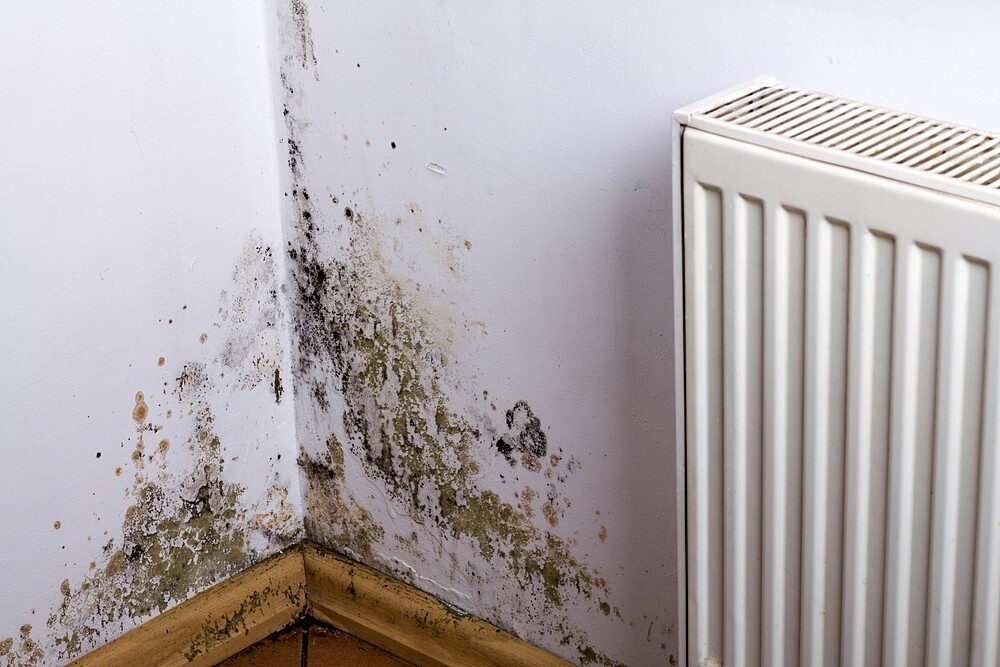If the humidity in your home is increased, mould can result and affect the regulation of your body temperature. You can find out how to lower the humidity here!
Humidity: What does that mean?
- As soon as water evaporates in a room, the atmospheric humidity increases. The relative humidity of a room is expressed in percentages and can therefore range from 0 to 100%.
- At a humidity of 100%, the air is completely saturated with water – accordingly, no additional water can evaporate and the excess moisture condenses.
- The relative humidity in living spaces should ideally be 45% and not exceed the maximum value of 65%.
- A hygrometer is used to measure the relative humidity.
How does a high humidity arise?
- Sweat and breath increase the humidity in rooms.
- Water vapour is the main cause of high humidity: showering and cooking increases the humidity in rooms enormously.
- Dryers, washing machines, wet linen and wet shoes are also considered to be sources of moisture.
- Indoor plants, which release water into the air via the leaf surface, are also responsible as additional sources of humidity.
- Even indoor fountains cause an increase in humidity.
What is the effect of high humidity?
High humidity increases the risk of mould, which needs moisture and heat to grow. The spores of the moulds are dangerous for humans and can cause allergic reactions, among other things.
In addition, high humidity affects the regulation of our body temperature: when people sweat, this usually leads to evaporation of sweat, which cools the body. If the humidity is very high, the sweat can no longer evaporate well, which hinders the cooling effect. As a result, we feel uncomfortable and can have circulation problems, especially in summer.
Reducing humidity: How does that work?
Proper ventilation
Proper ventilation is essential for rooms with high humidity. It is essential to ventilate for about ten minutes – three to four times a day. Forced ventilation means opening the window fully and not tilting it. This should be started directly in the morning, as a lot of water is excreted during sleep. If the outside temperature is pleasant, a tilted window can also help to keep the humidity moderate overnight. Attention: Switch off the radiator when airing out!
Reducing humidity in the bathroom and kitchen
After showering or cooking, a lot of water vapour accumulates in the air. The window should also be opened directly afterwards. When cooking, it is also advisable to use a pot lid. This prevents the water vapour from escaping and it condenses on the lid – and we save energy as well. Alternatively, an extractor hood can help!
Separate room for damp objects
Washing machine, dryer and damp laundry belong best in a separate room where good ventilation can take place. Also distribute your indoor plants around the apartment so that not all plants are in one room.
Dehumidify air thanks to home remedies
Salt and rice absorb moisture and therefore serve as good household remedies to regulate humidity. Fill a layer of salt (without iodine or fluoride) or rice into several small bowls and place them on top. The food will bind the moisture and clump together after a while. After some time the contents must be replaced.
Electric dehumidifiers
The air is dried with an electric dehumidifier. Excess moisture is thereby collected.
Constant room temperature
- Air temperature and humidity are partly related: warm air can absorb more moisture than cold air. With a room temperature of 20 to 22 degrees you are in the optimal range so that the humidity does not rise too much.
- In winter, cold bridges can cause moisture to accumulate more quickly. If cold air flows into a warm room through leaky windows, the water in this area condenses more quickly. Therefore, cold bridges should be avoided.

